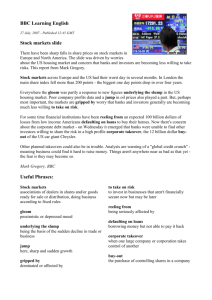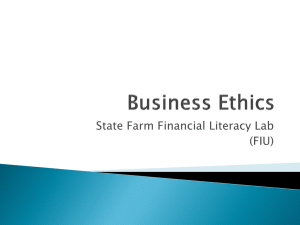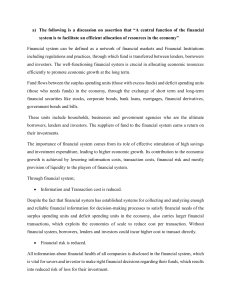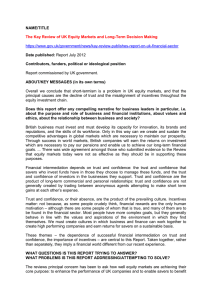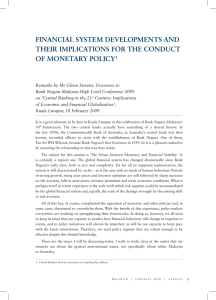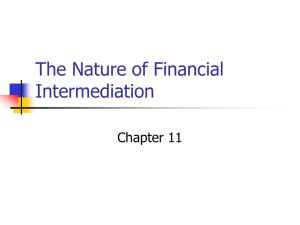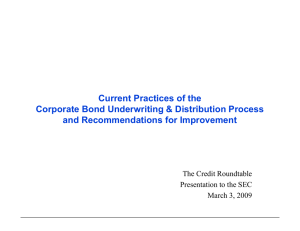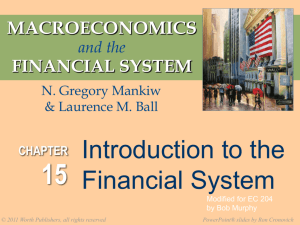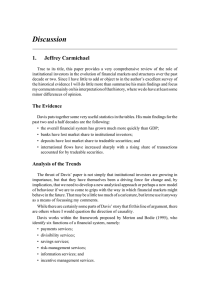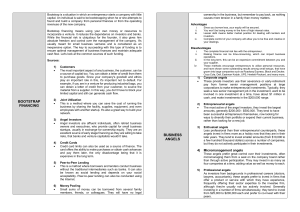Money
advertisement
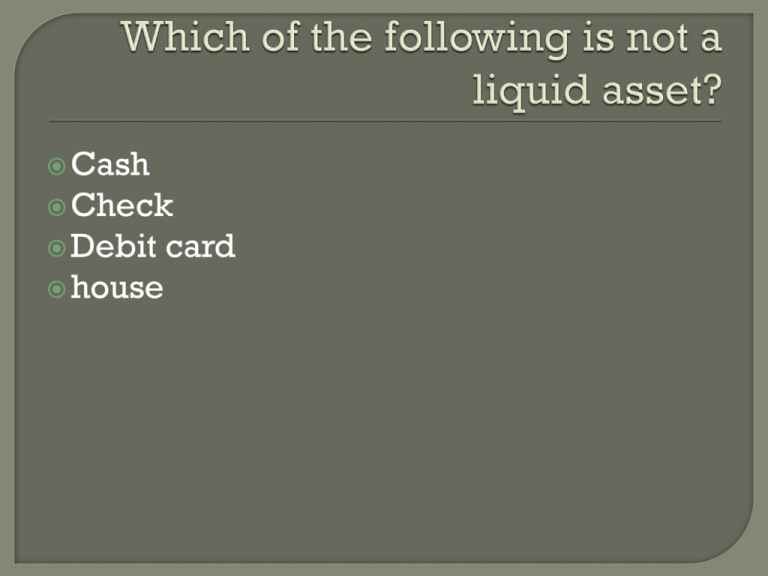
Cash Check Debit house card Why does the US dollar have such a good value? Chapter 10 Chapter 10 Section 1 SSEMI1b Explain the role of money as a medium of exchange and how it facilitates exchange. Use of money is a social custom • Its role is to facilitate exchange Money itself is any asset accepted as payment for goods or services Without money we would barter like traditional societies • Although barter works it can be complex and inefficient 1. Medium of Exchange: commonly accepted payment 2. Unit of Account: standardized and easily measured 3. Store of Value: holds purchasing power over time What are the 6 characteristics of money? On the island of Yap, large circular stones are used for money. The main reason why this type of money serves its function as a medium of exchange is because it is A very portable B highly divisible C accepted as payment D prized in foreign transactions Barter http://www.youtube.com/watch?v=J7hN Ot2Y0J8 National Geographic – Inside America’s Money Vault http://www.youtube.com/watch?v=WmV GYLTROnQ Durable—lasts for an extended period Portable—easy to carry & exchange Divisible—easily broken into measurable units Uniform—similar in appearance and has a standard value Scarce—Not overly printed or in too great abundance Accepted—Society is certain that it has value Fiat—has value because the government says so • “legal tender” Representative— stands in for money • IOU, silver certificate Commodity—has other uses besides acting as money • Tobacco, water Money supply all the money available in the economy • This includes money in and out of banks • Liquidity refers to how easily an asset can be turned into cash • Federal Reserve tracks the amount of money “in circulation” or in the economy Chapter 10 Section 3 The Financial System—various markets, players and institutions that coordinate the channeling of funds between borrowers and savers • Borrowers—demand money from the system with the knowledge that they will have to pay it back with interest • Savers—supply money to the system with the expectation that it will be paid back to them with interest Investment Banks—raise money for companies (perhaps even nations) and manage wealth of private investors (merchant bank) • JPMorgan, Goldman Sachs Credit Unions—cooperative lending for specific groups • Marshland, Teachers Commercial Banks—offer a wide range of lending services to the public (retail bank) • Bank of America, United Community Banks serve several purposes: 1. Store Money—safe and insured 2. Vehicle for Saving— variety of accounts available 3. Loans—renting money at a cost 4. Credit—form of deferred payment • • Principal is amount owed Interest is cost of renting the principal FDIC preserves and promotes public confidence in the U.S. financial system by • insuring depositors • identifying, monitoring and addressing risks to the deposit insurance funds • limiting the effect on the economy and the financial system when a bank or thrift institution fails Chapter 11 Section 1 “A [financial] market is an aggregation of what people think the future is going to be like.” ~ Dan Mathisson When a saver, or investor, makes a purchase on the financial market they gain a financial asset • AKA securities, these are claims on a borrower’s repayments and potential interest Most investors will not meet borrowers, they will move through an intermediary • These are companies and institutions that offer financial products Dealing with intermediaries offers 3 advantages: 1. Sharing of risk • institutions can diversify, or spread, an investors money out into multiple investments to reduce risk Access to information 2. • Managers and companies provide portfolios and prospectuses that explain companies’ profits, losses, products, etc. Liquidity 3. • Banks can offer a guaranteed return, or money back above what was invested—something more secure than giving money to a friend Investing generally refers to the use of resources or assets to earn income or profit in the future There are many vehicles, or instruments, for investment such as property, stocks or bonds, savings, etc. • Investing happens over the short or long term • Investors look for “return” or the ratio of money gained to lost when searching for or evaluating opportunities Stock is a claim on part of a company’s earnings as ownership • They are sold in shares, or portions (AKA equities) Owning stock yields a profit 2 ways: 1. Dividends—a portion of a company’s profits paid to investors during the year 2. Capital gains—to sell a stock for more than the price for which it was purchased Stock is purchased on a stock exchange • a financial market An individual opens an account with a brokerage firm and can purchase stock online an • Those trades are executed on the “floor” of a physical market • NYSE is America’s oldest and largest and located on Wall Street, NYC Markets generally fluctuate constantly throughout a year or even a day • When stock prices steadily rise it is called a bull market; steady fall is a bear market These prices are listed on many different indices: • NASDAQ—favors tech companies • S&P 500—tracks 500 companies (more diverse) • DJIA—30 largest American companies (Dow) Another common asset is a bond—an IOU Investors loan money to a corporation or government and are repaid, with interest, over a period of time • When full payment is due back to the investor, the bond has matured • How much the bond would pay if held to maturity is its yield These and other complex financial products are traded on financial markets Capital Markets offer lending for over a year Money Markets offer lending for less than year • Primary markets allow on the original buyer to redeem payment • Secondary markets allow the asset to be resold Eric received a $2,000 bonus from his employer. He deposited the entire amount in a one-year certificate of deposit with a simple interest rate of 5%. When the CD matured, how much interest had Eric earned? A $10 B $20 C $50 D $100




